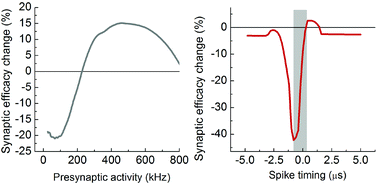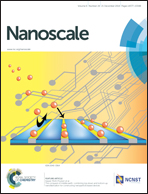Multiprotocol-induced plasticity in artificial synapses†
Abstract
We suggest a ‘universal’ electrical circuit for the realization of an artificial synapse that exhibits long-term plasticity induced by different protocols. The long-term plasticity of the artificial synapse is basically attributed to the nonvolatile resistance change of the bipolar resistive switch in the circuit. The synaptic behaviour realized by the circuit is termed ‘universal’ inasmuch as (i) the shape of the action potential is not required to vary so as to implement different plasticity-induction behaviours, activity-dependent plasticity (ADP) and spike-timing-dependent plasticity (STDP), (ii) the behaviours satisfy several essential features of a biological chemical synapse including firing-rate and spike-timing encoding and unidirectional synaptic transmission, and (iii) both excitatory and inhibitory synapses can be realized using the same circuit but different diode polarity in the circuit. The feasibility of the suggested circuit as an artificial synapse is demonstrated by conducting circuit calculations and the calculation results are introduced in comparison with biological chemical synapses.


 Please wait while we load your content...
Please wait while we load your content...